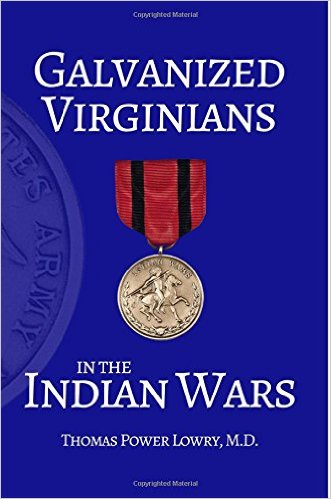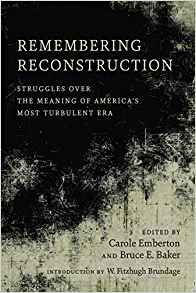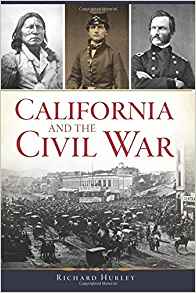Galvanized Virginians in the Indian Wars by Thomas Power Lowry. Idle Winter Press, 2015. Paper, ISBN: 978-0692550748. $16.99.
 Working from the late Major Robert E. Denney’s invaluable database of 3,710 Confederate soldiers who joined the United States Volunteers during the Civil War, Dr. Thomas Power Lowry focuses on the wartime experiences of 292 Virginians and their decision to trade their gray for blue (vi). Because these men originally enlisted in the Confederate service before they took an oath to join the Union, their story is very different from other federal soldiers. Lowry finds that the Virginians in the six “galvanized” regiments had little or no community identity and, because of their choice to switch sides, a brass band welcome home was very unlikely. Yet, regardless of their choice to take the Oath of Allegiance, Lowry illustrates that these men were not cowards without conviction or loyalties, but rather hardworking, disciplined men who saw their federal service as a way to escape boredom, starvation, and disease in northern prisons. Just as one coats a steel bucket in zinc to keep it from rusting, these Confederate soldiers coated themselves in Union blue to survive.
Working from the late Major Robert E. Denney’s invaluable database of 3,710 Confederate soldiers who joined the United States Volunteers during the Civil War, Dr. Thomas Power Lowry focuses on the wartime experiences of 292 Virginians and their decision to trade their gray for blue (vi). Because these men originally enlisted in the Confederate service before they took an oath to join the Union, their story is very different from other federal soldiers. Lowry finds that the Virginians in the six “galvanized” regiments had little or no community identity and, because of their choice to switch sides, a brass band welcome home was very unlikely. Yet, regardless of their choice to take the Oath of Allegiance, Lowry illustrates that these men were not cowards without conviction or loyalties, but rather hardworking, disciplined men who saw their federal service as a way to escape boredom, starvation, and disease in northern prisons. Just as one coats a steel bucket in zinc to keep it from rusting, these Confederate soldiers coated themselves in Union blue to survive.
Over 3,000 Confederate prisoners took the Oath of Allegiance to the Union and joined the U.S. Volunteers. Each of these regiments contained men from many different Confederate regiments and many different locales, so to make his analysis more manageable, Lowry concentrates on the 292 Virginians in Denney’s database. He traces these individuals’ struggles against starvation, scurvy, smallpox, and Native American attacks. The Second and Third U.S. Volunteers, mostly recruited from Rock Island prison, contended with Native American attacks, poor roads, inadequate pay, weapons, ammunition, and supplies (76). Members of Fourth, Fifth, and Sixth U.S. Volunteers endured similar issues, as they were all hurried west to subdue Native Americans (81).
Lowry contends that the horrors of imprisonment compelled many Confederate prisoners to abandon their loyalty to the Confederacy and join the enemy. In accordance with the current Civil War prison scholarship, Lowry maintains that neither the Union nor the Confederacy was prepared to house, feed, or clothe the large numbers of prisoners they captured on the battlefield. However, he is careful not to defend prison commanders’ actions, maintaining that authorities on both sides were not willing to alleviate the suffering. Malnutrition, starvation, disease, and death, were especially prevalent in the five prison camps from which most of the “galvanized” Virginians were recruited—Point Lookout, Rock Island, Camp Douglas, Camp Morton, and Camp Alton. Lowry especially emphasizes the prevalence of scurvy and night blindness among prisoners as a result of malnutrition, allocating an entire chapter to the disease and its symptoms.
Building on Michele Tucker Butts’ analysis of the First Regiment in her Galvanized Yankees on the Upper Missouri—The Face of Loyalty, Lowry examines all six regiments of the U.S. Volunteers. Except for the work of Butts and Dorris Alexander Brown’s The Galvanized Yankees (1963), scholars have largely overlooked these regiments. In an attempt to honor these soldiers’ service and tell their story, Lowry focuses on their reasons to join the Union army, the struggles of military prison life, and their frontier experiences (64). By tracing the wartime lives of the Virginians who chose Union service over prison life, Lowry uncovers several trends: they died of disease less often than men still in active Confederate service or in prison and, not surprisingly, they deserted far more often than other Union soldiers. Yet, those who stayed until being mustered out became “veterans of not just the Union or the Confederacy but veterans of a whole new country, a first step in the long and still-continuing struggle against the bitterness of sectionalism” (186). Lowry declares: “they were remarkably loyal to their new allegiance, they earned the respect of the hardened veterans of frontier warfare, and they deserve remembrance” (vi).
Lowry’s investigation of the six “galvanized” regiments brings much-needed attention to those Confederate soldiers who volunteered for Union service in hopes of surviving the war. Perhaps other historians will continue Lowry’s work and analyze the “galvanized” alumni of the remaining Confederate states. Likewise, historians can turn their attention to the Union prisoners who joined Confederate fighting units. The subject of “galvanized” rebels or Yankees is relatively unexplored territory, but thanks to Lowry and Denney’s database, historians can begin to rescue these men from obscurity.
Although Lowry’s book inspires an important conversation about loyalty, cowardice, and suffering, his book has some weaknesses, especially in regards to the most recent historiography. For instance, Lowry states that the most reasonable estimate of Civil War deaths is 600,000 (2). This is an outdated estimate, as J. David Hacker demonstrates in his groundbreaking 2011 Civil War History article, “A Census-Based Count of the Civil War Dead.”[1] Furthermore, although Lowry demonstrates that many of the Virginians remained in Union service until their mustering out, he does not include a discussion of nineteenth-century American concepts of honor and masculinity. These discussions would only strengthen his work; their absence leaves many questions unanswered.
Nonetheless, Lowry offers an enjoyable, thought-provoking story of the 292 “galvanized” Virginians. This book is best for American Civil War enthusiasts who are interested in the uncommon Civil War soldier and prisoner-of-war experience.
Angela M. Riotto is a doctoral candidate in history at the University of Akron.
[1]J. David Hacker, “A Census-Based Count of the Civil War Dead,” Civil War History 57, no. 4 (December 2011): 307-348.




